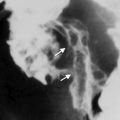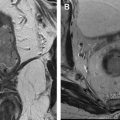Magnetic resonance (MR) imaging has been widely accepted as a powerful imaging modality for the evaluation of the pelvis because of its intrinsic superior soft tissue contrast compared with that of computed tomography. In certain cases, however, the morphologic study provided by MR imaging may not be enough. Functional evaluation with perfusion and diffusion, which allow estimation of the microvascular characteristics and cellularity of the lesions, favors the differentiation of benign from malignant lesions. This article focuses on new magnetic resonance techniques and their contribution to the differentiation and characterization of pelvic pathologies.
Key points
- •
Magnetic resonance (MR) has been widely accepted as a powerful imaging modality for the evaluation of the pelvis because of its intrinsic superior soft tissue contrast compared with other imaging modalities.
- •
MR imaging is mainly used for staging of uterine cancers and as a problem-solving modality in patients with ultrasonographically indeterminate masses.
- •
MR imaging provides multiplanar imaging of the zonal pelvic anatomy, mainly through high-resolution T2-weighted images.
- •
Functional study with perfusion and diffusion allows the evaluation of microvascular characteristics and cellularity of the lesions.
- •
Functional evaluation favors the differentiation of benign from malignant lesions.
Stay updated, free articles. Join our Telegram channel

Full access? Get Clinical Tree





